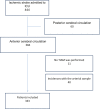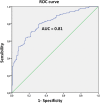Association between post-procedural hyperoxia and poor functional outcome after mechanical thrombectomy for ischemic stroke: an observational study
- PMID: 31127402
- PMCID: PMC6534627
- DOI: 10.1186/s13613-019-0533-8
Association between post-procedural hyperoxia and poor functional outcome after mechanical thrombectomy for ischemic stroke: an observational study
Abstract
Background: The actual effects of oxygen therapy on patients who have suffered a stroke are still unknown, and its recommendation as a routine measure in emergency services remains controversial. The aim of this study is to determine the effect of hyperoxia in functional recovery in patients with ischemic stroke who underwent intra-arterial mechanical thrombectomy (IAMT).
Methods: A prospective observational cohort study that included all adult patients consecutively admitted to the intensive care unit (ICU) due to an ischemic stroke in the anterior cerebral circulation and following an IAMT intervention, between 2010 and 2015. All patients were intubated and connected to mechanical ventilation for the intra-arterial therapy, receiving supplementary oxygen to achieve saturations above 94%. Two groups were established regarding oxygen partial pressure (paO2) reached. It was based on a single ICU admission blood gas analysis. The hyperoxia group was defined as paO2 > 120 mmHg. We measured functional recovery in each of the groups according to the modified Rankin scale after 90 days.
Results: For the analysis, a total of 333 patients were included. High levels of paO2 were mostly related to higher scores in modified Rankin scale (mRS) after 90 days. There were 60.6% cases with mRS ≥ 4 and 70.6% with mRS ≥ 3 in the hyperoxia group, compared to 43.0% and 56.1% in the paO2 ≤ 120 group, p < 0.01, respectively. Mortality was higher in the hyperoxia group, 28.6% vs 18.7%, p = 0.04. After regression adjustment by confounding factors, poor functional outcome was still significantly higher in the hyperoxia group, for both mRS ≥ 4 and mRS ≥ 3: OR 2.2.7, IC 95%, 1.22-4.23, p = 0.01 and OR 2.07, IC 95%, 1.05-4.029, p = 0.04, respectively. Both the National Institute of Health Stroke Scale Score (NIHSS) values at 24 h after the IAMT and the days of ICU stay were significantly higher in the hyperoxia group.
Conclusions: In patients with ischemic stroke in the anterior cerebral circulation treated with IAMT, we found an association between admission PaO2 > 120 mmHg and worse functional outcome 90 days after ischemic stroke, but this association needs further confirmation by other studies.
Keywords: Cerebral blood flow; Hyperoxia; Ischemic; Mortality; Oxygen; Stroke.
Conflict of interest statement
The authors declare that they have no competing interests.
Figures



Similar articles
-
The Role of Anesthesia during Intra-Arterial Mechanical Thrombectomy for theTreatment of Acute Ischemic Stroke.Cureus. 2019 Oct 3;11(10):e5831. doi: 10.7759/cureus.5831. Cureus. 2019. PMID: 31754566 Free PMC article.
-
Association of oxygenation levels after successful mechanical thrombectomy under general anesthesia and 3-month functional outcome in patients with acute ischemic stroke: A prospective observational study.Anaesth Crit Care Pain Med. 2025 Apr;44(2):101494. doi: 10.1016/j.accpm.2025.101494. Epub 2025 Feb 21. Anaesth Crit Care Pain Med. 2025. PMID: 39988232
-
Arterial blood gas analysis predicts futile recanalization in mechanical thrombectomy-treated acute ischemic stroke patients: a multicenter study.Eur Rev Med Pharmacol Sci. 2024 Feb;28(4):1594-1604. doi: 10.26355/eurrev_202402_35488. Eur Rev Med Pharmacol Sci. 2024. PMID: 38436197
-
Arterial hyperoxia and mortality in the cardiac intensive care unit.Curr Probl Cardiol. 2024 Oct;49(10):102738. doi: 10.1016/j.cpcardiol.2024.102738. Epub 2024 Jul 17. Curr Probl Cardiol. 2024. PMID: 39025170 Review.
-
Association of General Anesthesia vs Procedural Sedation With Functional Outcome Among Patients With Acute Ischemic Stroke Undergoing Thrombectomy: A Systematic Review and Meta-analysis.JAMA. 2019 Oct 1;322(13):1283-1293. doi: 10.1001/jama.2019.11455. JAMA. 2019. PMID: 31573636 Free PMC article.
Cited by
-
A prospective study on the administration and titration of oxygen therapy in mechanically ventilated patients.J Anaesthesiol Clin Pharmacol. 2025 Jul-Sep;41(3):433-440. doi: 10.4103/joacp.joacp_199_24. Epub 2025 Feb 22. J Anaesthesiol Clin Pharmacol. 2025. PMID: 40635808 Free PMC article.
-
The Effect of Hyperoxemia on Neurological Outcomes of Adult Patients: A Systematic Review and Meta-Analysis.Neurocrit Care. 2022 Jun;36(3):1027-1043. doi: 10.1007/s12028-021-01423-w. Epub 2022 Jan 31. Neurocrit Care. 2022. PMID: 35099713 Free PMC article.
-
Prognostic significance of platelet-to-lymphocyte and platelet-to-neutrophil ratios in patients with mechanical thrombectomy for acute ischemic stroke.J Cerebrovasc Endovasc Neurosurg. 2022 Sep;24(3):221-231. doi: 10.7461/jcen.2022.E2021.10.003. Epub 2022 Apr 21. J Cerebrovasc Endovasc Neurosurg. 2022. PMID: 35443275 Free PMC article.
-
Neurological outcomes and mortality following hyperoxemia in adult patients with acute brain injury: an updated meta-analysis and meta-regression.Crit Care. 2025 Apr 23;29(1):167. doi: 10.1186/s13054-025-05387-7. Crit Care. 2025. PMID: 40270034 Free PMC article.
-
Predicting Factors of Functional Outcome in Patients with Acute Ischemic Stroke Admitted to Neuro-Intensive Care Unit-A Prospective Cohort Study.Brain Sci. 2020 Nov 26;10(12):911. doi: 10.3390/brainsci10120911. Brain Sci. 2020. PMID: 33256264 Free PMC article.
References
-
- Organisation WH, WHO: stroke, cerebrovascular accident. Stroke 2011; health topics: stroke http://www.who.int/topics/cerebrovascular_accident/en/index.html.
LinkOut - more resources
Full Text Sources

